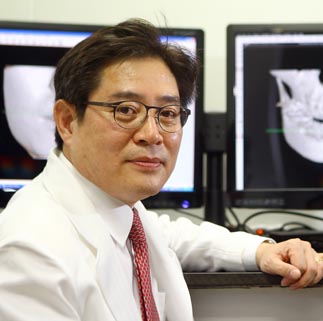Forensic sleuths to be allowed at crime scenes

Seo Joong-seok explains the importance of crime scene investigations on Sept. 19 while showing an X-ray of a corpse on his computer. By Kim Sang-seon
Faced with a dead end, Seo Joong-seok, head of forensic science at the National Forensic Service, was determined to find the smoking gun.
On Feb. 16, Seo showed up at an apartment in Mapo District, western Seoul, where the pregnant wife had been found dead, to personally examine the crime scene.
It was an unusual move. In Korea, forensic scientists do not appear at crime scenes, barring special cases, instead relying on the police to gather and document evidence.
But standing in the bathroom of the apartment, Seo checked the location of the bathtub where the woman had been found, examining the material as well.
He moved on to the bedroom, where he found the smoking gun that police had failed to notice: blood stains belonging to the victim.
“There is a high possibility that this case was not an accident,” the prosecutors’ wrote in their reapplication for an arrest warrant.
Baek was finally arrested, and last week, was sentenced to 20 years in prison for the murder of his wife and unborn baby.
In an interview with the JoongAng Ilbo last Monday at the NFS in Sinwol-dong, western Seoul, Seo said that he was certain that the victim did not die from slipping in the bathtub, after seeing the location and the shape of the bathtub.
“These pieces of evidence can only be perceived by those with forensic knowledge,” Seo said, adding that forensic experts in Korea should be present at all crime scenes, like in the United States.
Seo’s hopes may soon become reality. The NFS, with the backing of the National Police Agency, is planning to establish on-site examination centers in Yangcheon District and Gangseo District, western Seoul, as early as the end of November.
Forensic scientists would be based at the centers and be on call to go to crime scenes around Seoul. Most critically, the centers would facilitate forensic experts in examining corpses at the scene of the crime.
Currently, forensic scientists conduct autopsies without going into field studies. The arrangement, Seo said, was not ideal: A cause of death can be judged differently depending on myriad factors at the time of death, including the posture and location of the corpse as well as what the person was wearing and even the day’s weather.
“Evidence that can be gathered from a corpse perishes as time goes by,” Seo said. “But it can be prevented if forensic scientists quickly collect clues and evidences at the crime scene.”
Seo is not only a believer in bringing forensic scientists to the scene of the crime. While working at a branch office of the NFS, he and two other colleagues ran a pilot on-site mobilization system for three years starting in 2002.
Visiting crime scenes around the region, including in Daejeon and the Chungcheong area, Seo and his partners were able to solve 2,500 deaths during that time.
In order to operate on-site examination centers successfully, Seo said more forensic scientists were needed in the country.
“One forensic scientist conducts about 150 to 200 autopsies a year in the United States, but in Korea, one person conducts about 250 to 300 autopsies a year,” Seo said. “Recently, eight medical school graduates applied to work at the NFS, but due to an insufficient budget, we are not able to hire them.”
By Kim Hyo-eun [sharon@joongang.co.kr]
한글 관련 기사 [중앙일보]
CSI처럼 … 국과수도 범죄 현장 간다
지난 2월 16일 서울 마포구의 한 아파트. ‘만삭 의사부인 사망사건’ 현장에 서중석 국립과학수사연구원(국과수) 법의학부장이 나타났다. 피의자로 지목된 남편 백모(31)씨의 구속영장이 증거 불충분으로 기각됐기 때문이다. 우리나라는 사건 현장에 법의학자가 나가지 않는다. 그러나 현장 상황을 보지 않고서는 사건을 해결할 수 없다는 게 서 부장의 판단이었다. 그는 경찰이 찾지 못한 증거가 없는지 확인하기 위해 시신이 발견된 욕실 욕조의 위치와 재질, 상태 등을 꼼꼼히 살폈다. 결정적으로 안방에서 피해자의 혈흔 등이 발견됐다. 검찰은 “사고사가 아닐 가능성이 크다”는 국과수 의견서 등을 추가해 영장을 재청구했다. 백씨는 구속됐고, 1심에서 징역 20년이 선고됐다.
19일 서울 신월동 국과수에서 만난 서 부장은 “피해자가 발견된 욕조의 모양과 위치를 보니 넘어져서 사망한 것이 아니라는 확신이 들었다”며 “법의학적 지식이 있어야 찾을 수 있는 증거”라고 설명했다. 그는 “현장은 검시의 시작이자 끝”이라며 “이제 국과수도 미국의 CSI(Crime Scene investigation·과학수사대)처럼 법의학자가 직접 사건 현장에 나가야 한다”고 말했다.
국과수는 이르면 11월 말부터 서울 본원이 있는 양천구와 강서구에 ‘현장검안센터’를 설치해 시범 운영할 계획이다. 법의학자들이 센터에 상주하면서 직접 현장에 나가 시신을 보고 증거물을 채취한다는 것이다. 경찰청도 검안센터 장소 확보 등을 지원하기로 했다.
지금까지 국과수는 현장조사 없이 부검만 담당해왔다. 경찰 과학수사대가 현장 감식을 하고, 시신 검안은 일반 의료기관의 의사 등이 하는 시스템이다. 서 부장은 “시신이 놓인 장소·자세·옷·날씨·사망 직전의 상황에 따라 사망의 원인을 다르게 판단할 수 있다”며 “시신에서 나오는 증거물도 시간이 흐르면 소멸되는데 법의학자가 현장에서 이를 신속하게 채취하면 그럴 우려가 없다”고 했다.
서 부장은 2002년부터 3년간 국과수 중부분원에서 근무할 당시 현장출동시스템을 시범 가동한 적이 있다. 서 부장은 동료 2명과 함께 대전·충청 지역을 돌며 2500건의 사망사건을 해결했다.
현장검안 센터의 성공을 위해 남은 과제는 법의학자 인력 확충이다. 서 부장은 “미국의 법의관 1명이 1년에 150~200구를 부검하고 있는데 우리는 250~300구를 부검할 정도로 인력이 부족하다”며 “현재 8명의 의대 졸업생들이 국과수에 지원했지만 예산 등의 이유로 채용을 못하고 있다”고 했다. 그는 “국가기관에 소속된 법의학자가 현장검안 참여를 법적으로 뒷받침하는 제도 개선도 시급하다”고 덧붙였다.










with the Korea JoongAng Daily
To write comments, please log in to one of the accounts.
Standards Board Policy (0/250자)